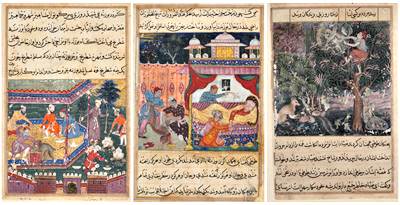'Interspecies Friendships' and Chess
A good subtitle to that title would be 'Don't play chess with a monkey'. This month's Flickr favorite doesn't really have much to do with chess, but the board in the left photo looks indeed to be that of our favorite board game.

Left:
The wounded monkey bites the hand of the prince...
© Flickr user museado under
Creative Commons.
The full title of the left photo said,
The wounded monkey bites the hand of the prince, his chessmate, in the presence of guests, from a Tuti-nama (Tales of a Parrot): Fifth Night c. 1560
The description continued,
This painting depicts a scene from the cautionary tale the mother parrot tells her young to warn them that interspecies friendships, like theirs with the fox cubs, are a bad idea. She tells them that there once was a monkey who could play chess, and he enjoyed many games with a prince. When the prince invited dignitaries for a party, the monkey made a bad joke, the prince slapped him, and the monkey bit him in return.
At the left, food is prepared as the guests look on in astonishment. An inscription at the bottom of the page names the artist, who went on to become one of the most celebrated Indian masters at the Mughal court. • Mughal India, court of Akbar (reigned 1556–1605)
The title of the middle photo said,
The monkey slain, his blood to be used as medicine for the ailing prince he has bitten, from a Tuti-nama [etc. etc.]
The description said,
Wounded by the chess-playing monkey’s bite, the prince’s hand became increasingly infected. The only cure, his doctors said, was to apply the blood of the monkey to the wound and let it dry. Reluctantly, the prince allowed the monkey to be killed. Two men accomplish this serious work at the left.
In the right margin is written the name of the artist, the celebrated Basavana. The Tuti-nama contains the earliest known paintings by the prolific master who was instrumental in shaping the Mughal painting style over subsequent decades.
The title of the photo on the right said,
The hunter throws away the baby parrots, who pretend to be dead, and captures the mother, from a Tuti-nama [etc. etc.]
The description said,
Despite the chess-playing monkey’s grim end, the baby parrots continued to cavort with the fox cubs. One day the mother fox discovered that her cubs had been eaten by a panther. Blaming the parrots, she lured a hunter to their tree. The hunter climbed the tree and ensnared the mother parrot and her babies. The mother instructed her young to play dead, then pleaded with the hunter to take her alone, saying that since she knew the art of healing she would fetch a high price.
Lush vegetation and a stream of water painted with a soft brush indicate a fresh new stylistic vision that represents a departure from Indian and Persian styles that came before.
All three Flickr pages mention, 'This photo is in 1 album: Cleveland Museum of Art'.




No comments:
Post a Comment